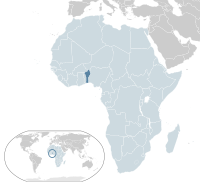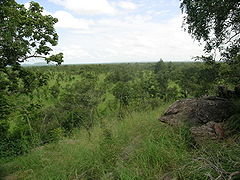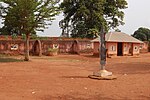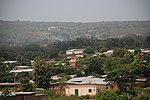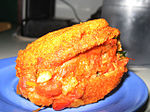|
Vikidia currently has 4,621 articles. Improve it! |
|
Join Vikidia: create your account now and improve it! |
Benin
| Benin | |||
|
| |||
| Official languages Capital |
French Porto Novo | ||
| Area Government |
112,622 km2 Republic | ||
| Population Religion |
10,323,000 (in 2002) Christianity (42.8%), Islam (24.4%), Vodun, a traditional religion of Benin (17.3%), Other local traditional religions (6%), Other religious groups (1.9%), No religion (6.5%) | ||
| Time zone Currency |
UTC+1 West African CFA franc | ||
| Demonym |
Beninese | ||
| Monarch |
Current Previous |
||
Benin is a small country in Western Africa. It was called Republic of Dahomey from 1958 to 1975, and was a colony of France before (French Dahomey).
Etymology[edit | edit source]
The name Benin comes from the Bight of Benin, itself coming from the Benin kingdom.
Geography[edit | edit source]
Benin is a small country, eight times smaller than Nigeria but about twice as big as Togo.
It has a population of more than 10 million people living mostly in cities located near the Bight of Benin such as Cotonou, Abomey or Porto Novo (the capital of the country).
There are two seasons in Benin (like most countries in Africa): the dry season, where the temperature can rise up to 40 °C and the wet season, where the temperature drops to 15 °C.
It is a poor country, one of the poorest of the world.
Location[edit | edit source]
The country shares its borders with four countries: Togo, Burkina Faso, Niger and Nigeria. Its southern coast belongs to the Bight of Benin.
Benin is situated in a tropical region. Only the region close to the sea has an equatorial climate and there is a semi-arid climate in the north-east.
Rivers[edit | edit source]
The rivers in Benin are wild rivers.
Benin has six major rivers:[1]
- the Mékrou river (between Benin and Niger), the longest river of Benin (410 km long);
- the Mono river (between Togo and Benin), 100 km long;
- the Niger river (also between Niger and Benin);
- the Ouémé river and the Couffo river (at the Bight of Benin);
- the Pendjari river (between Benin and Burkina Faso);
- the Sota river, 250 km long (on the borders between Niger and Benin).
Natural regions[edit | edit source]
There are a lot of forests, national parks in Benin, especially in north (the south is more urban, and most of the cities are more next to the sea (Porto Novo or Cotonou).
National parks[edit | edit source]
The two most important national parks in Benin are:
- the W National Park (more than one million hectares), which is also in Burkina Faso and in Niger, and protected by the Ramsar convention;
- the Pendjari National Park.
Forests[edit | edit source]
There are many forests in Benin. These are the most important ones (coming from North and going to the sea):
- the Goungoun Forest;
- the Sota Forest;
- the Superior Alibori Forest;
- the Trois-rivières Forest;
- the Quenou Benou Forest;
- the Superior Ouémé Forest;
- the Ouari Maro Forest;
- the Kouffé mountains Forest;
- the Toui-Kilibo Forest;
- the Agoua Forest;
- the Dogo Forest;
Hunting zones[edit | edit source]
There are three important hunting zones: the hunting zone of Djona, the hunting zone of Pendjari and the hunting zone of Latakora.
Departments[edit | edit source]
There are 12 departments in Benin:
Each department is administered by a prefect.
Cities[edit | edit source]
The capital of Benin is Porto Novo. It is situated near the sea.
The largest and most inhabited city is Cotonou. More than 800 thousand people live there. It is the economic center of Benin.
Here is the list of the cities in Benin (the ten most inhabited ones are in bold):[2]
- Abomey
- Abomey-Calavi
- Allada
- Aplahoué
- Athiémé
- Banikoara
- Bassila
- Bembèrèkè
- Bétérou
- Bohicon
- Bori
- Boukoumbé
- Comé
- Cotonou
- Cové
- Dassa-Zoumé
- Djougou
- Dogbo-Tota
- Ganvie
- Godomey
- Grand Popo
- Kandi
- Kérou
- Kétou
- Kouandé
- Lokossa
- Malanville
- Natitingou
- Ndali
- Nikki
- Ouidah
- Parakou
- Péhonko
- Pobé
- Porga
- Porto Novo
- Sakété
- Savalou
- Savé
- Ségbana
- Tanguiéta
- Tchaourou
Porto Novo (the capital)
Languages[edit | edit source]
The official language of Benin is French.
There are also lots of other languages, such as Peul, Yoruba, and Fon.
Benin is the 41th most multilingual country in the world, before France and after UK.[3]
Food[edit | edit source]
The people of Benin often eat rice, corn (in southern Benin), tomatoes, beans and tropical fruits such as pineapples, kiwi, bananas, and oranges.
In Benin, they also eat fufu, a sort of dough made out of flour.
There are a lot of specialty foods from Benin, for example Wagasi cheese (made by the Fulani people in northern Benin), Acarajé, Moyo, Beye, Amiwo (red corn dough), Gari Dossi, Gari Pinnon, Féchouada (from Ouidah), but also red rice.
International politics[edit | edit source]
Benin is part of the African Union, the Community of Sahel-Saharan States, the West African Economic and Monetary Union and the Economic Community of West African States. It is also member of the United Nations and the World Trade Organization.
References[edit | edit source]
- ↑ "Réseau hydrographique" (homepage of the Asia-Pacific Network on Integrated Plant Nutrient Management).
- ↑ Wolfram Alpha
- ↑ A page on the website "Matadornetwork" with a ranking of the world's most multilingual countries.
- ↑ Afrik cuisine
| Geography Portal — Everything about geography, continents, regions, geology, water and climate... |

